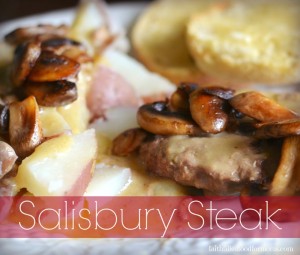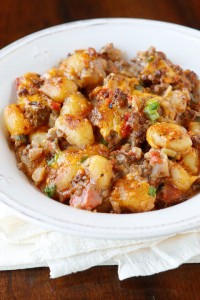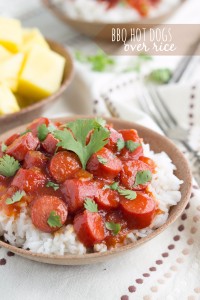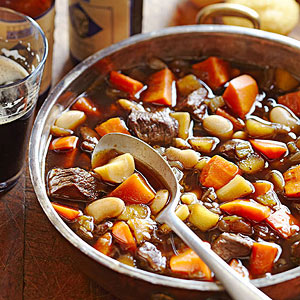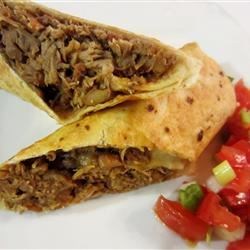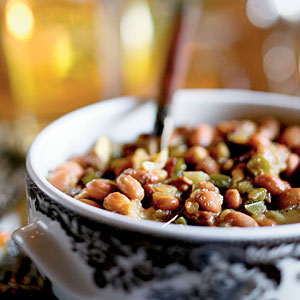SALISBURY STEAK WITH FROZEN BURGERS
Cattle 101: History, Breeds, Fun Facts, Terms
Cattle 101: History, Breeds, Fun Facts, Terms

Basic Terms
- Cow: Aadult female that has produced a calf
- Bull: Male animal
- Steer: Male animal that has been castrated and cannot breed
- Heifer: Young female that has not produced a calf
- Veal: Calves that are raised to 475-500 pounds
Over 98% of the beef animal is used when it is processed. About 45% of the animal is used for meat and the rest is used for other byproducts including leather, china, glue, film, soap, pharmaceuticals, insulin, gelatins.
The meat from cattle is called beef. The average American eats about 65 pounds of beef each year.
Fun Facts
• Cattle produce about 25 billion pounds of meat each year.
• The combined value of the cattle and beef industry is $200 billion.
• The hide from one cow can make 144 baseballs, 20 footballs or 12 basketballs.
• Disneyland (CA) sells over 4 million hamburgers each year.
History of Cattle
Not long ago cattle were used for many purposes including meat, milk, and labor. Today beef cattle are raised primarily to provide people with meat, and hundreds of useful by-products. Most cattle graze on grassland that is steep, hilly, dry or rocky and not suitable for building houses or growing crops. The main reason cattle are raised in different climates and settings all over the world is because they can thrive on low quality rangeland feed and grasses.
Cattle are descended from a wild ancestor called the aurochs. The aurochs were huge animals which originated on the subcontinent of India and then spread into China, the Middle East, and eventually northern Africa and Europe. Aurochs are one of the animals painted on the famous cave walls near Lascaux, France. People started domesticating aurochs between 8,000 and 10,000 years ago. Cattle were domesticated after sheep, goats, pigs, and dogs.
Cattle were first brought to the western hemisphere by Columbus on his second voyage to the New World in 1493. Spanish explorer Hernando Cortez took offspring of those same cattle to Mexico in 1519. In 1773, Juan Bautista de Anza brought 200 head of cattle to California to supply the early California missions.
Cattles Amazing Stomachs
Cattle are ruminants. This means they have one stomach with four separate compartments. Their digestive system allows them to digest plant material by repeatedly regurgitating it and chewing it again as cud. This digestive process allows cattle to thrive on grasses, other vegetation, and feed. A cow chews its cud for about eight hours a day. When an animal chews its cud it is a sign of health and contentment. Other ruminant animals include deer, elk, sheep, and goats.
Life Cycle
Many ranchers run cow-calf operations. They keep a herd of cows to produce calves. The cows are bred to calve in the spring or fall. Cows, like humans, are pregnant for nine months.
Newborn
On average a calf will be 70-80 lbs. at birth.
Within the first couple hours after birth, newborn calves will be up and wanting to nurse.
Colostrum, a cow’s first milk after birth, is very important to a newborn and should be consumed as soon as possible.
Colostrum contains antibodies vital for the newborn and has twice the calories of regular milk.
Calves are born with no protection from diseases, so their antibodies come from their mother’s milk.
Calves absorb antibodies from the colostrum directly into their bloodstream through pores in their intestinal lining. Within the first few hours the intestinal walls begin to thicken and the pores close up. By the time they are six hours old they can only absorb a fraction of what they need.
After filling their stomachs calves may feel like bucking and playing.
Calves
For the first three weeks of the calf’s life they only drink their mother’s milk, because their rumen is not yet fully developed. Rumen is one of the stomach chambers in ruminant animals. Humans do not have rumens. Between 3-8 weeks the calf goes through a transitional period where they start eating some hay and grass along with the milk. After eight weeks the calf’s rumen should be fully functioning. The rumen will grow 25 times larger from birth to adulthood.
Tagging, Branding & Earmarks
A newborn calve is commonly tagged. Each ear tag has an individual number which helps ranchers pair the mother with their young and track the calf through its lifecycle. Within the first few months, the calves will be branded. A brand is an identification mark for cattle. It can either be a hot iron brand or a freeze brand. Some operations use earmarks, as an additional way to identify their cattle. During branding all calves are vaccinated to help prevent disease. The young male calves are castrated during the first few months. After castration, they are referred to as steers.
Adulthood – Finishing
Calves are usually sold after they are weaned, at about six-eight months. After weaning, cattle are sent to feedlots for approximately 120 days where they are fed a high-energy ration of grain and hay. After this time called finishing, the cattle are sent to a harvest plant.
To keep the herd size approximately the same, ranchers save replacement heifers (females). The steers (males) will be sent to the feedlot while a few heifers are kept behind to raise and later produce calves themselves. Other heifers will go to the feedlot as well. Steers are more common in the beef industry, because they grow faster and naturally have more muscle.
The ideal breeding age for heifers is at least 14-16 months of age, depending on breed. Heifers should be about 65% of their mature weight before breeding.
Cattle Breeds
There are numerous breeds of cattle raised in the United States. Some breeds have been around for centuries, while others have been developed in the last couple of decades by mixing older breeds. Each breed is characterized by different traits suchs as size, weather tolerance, color, markings, hair length, and temperament.
There are two classifications; Bos indicus and Bos taurus. Bos taurus includes British and Continental. British breeds, also known as English breeds, are smaller in size than Continental breeds. These breeds are the foundation of the United States beef herds. Common English breeds include Angus, Red Angus, Shorthorn, and Hereford.
Continental breeds, also called Exotics, originated in Europe. They are larger in size, lean, muscular, and can tolerate hot climates. Continental breeds include Charolais, Limousin, Simmental, and Salers.
Bos indicus are humped cattle originating from South Central Asia. They are adapted to the stresses of heat, humidity, parasites, and poorly digestible forages. Bos indicus breeds are often found in the southern United States. Common bos indicus breeds are Brahman, Brangus, Beefmaster, Simbrah, and Santa Gertrudis.
Beef Nutrition
Beef is a nutritionally rich food and an excellent source of ten essential nutrients. A three-ounce serving of lean beef contributes more than 10% of the daily recommended value of protein, zinc, vitamin B12, selenium, phosphorous, choline, niacin, vitamin B6, iron and riboflavin. Beef is among the top food sources for protein, zinc and vitamin B12.
Some common types of lean beef cuts include: top sirloin steak, 95% lean ground beef, rib eye steak, T-Bone and tenderloin steak. The U.S. Department of Agriculture’s Nutrient Database shows that many cuts of beef are 20% leaner than they were 15 years ago. Half of the fatty acids found in beef are monounsaturated, the same “good healthy fat” found in olive oil.
Beef By-Products
Besides meat and milk, cows provide us with hundreds of important by-products. Almost the entire beef animal can be used in some way. From a typical 1,000 pound steer, slightly over 40% of the animal is used for retail beef and the remaining 60% is processed into by-products.
Beef by-products are anything made from a beef animal other than meat. You probably use more beef by-products than you think! Some edible examples include margarine, gelatin and marshmallows. Non-edible by-products include leather, soap, cosmetics, crayons and buttons. Cattle also contribute to the health industry. Here are some examples.
Bone, Horn, Hooves, and Gelatin: combs, gelatin candy (Gummy Bears), photographic film, steel ball bearings, fine bone china, pet food, and vitamin capsules/gel coatings.
Hide and Hair: insulation, paintbrushes, glue for bookmaking and band-aides, clothes, shoes, luggage, saddles, furniture, automobiles, volleyballs, basketballs, and baseball gloves.
Fats and Fatty Acids: shampoo, shaving creams, deodorants, candles, crayons, floor wax, detergents, hydraulic brake fluid, plastics, insecticides, paints, perfumes, and synthetic rubber.
Vocabulary Terms
Auroch: the ancient ancestor of domesticated cattle.
Beef By-products: anything made from a beef animal other than meat.
Bovine: scientific name for cattle.
Brand: identification mark on cattle; either hot iron or freeze brand.
Breed: group of animals that have the same ancestry and characteristics.
Bull: a mature male who has not been castrated.
Calf: young animal, either male or female, less than one year.
Calve: to give birth to a calf.
Castration: to remove the testicles of male cattle.
Cow: a mature female that has given birth, usually 2 or more years of age.
Cow-calf operation: a ranch or farm where cows are raised and bred to produce calves.
Cud: the portion of food that an animal regurgitates to chew for the second time.
Dual-purpose: being used for both milk and meat production.
Earmark: identification tool where part of the ear is removed to show ownership.
Feedlot: also know as a feedyard; a type of animal feeding operation used for finishing animals before they are ready for harvest.
Finish: to ready cattle for market, by feeding to a desired weight.
Forages: plant material, mainly leaves and stems, eaten by livestock.
Heifer: a young female cow that has not yet had her first calf. Most heifers have their first calf when they are about two years old, depending on the breed.
Horned: born with horns, usually removed at a young age.
Polled: born without horns, naturally hornless.
Regurgitation: controlled flow of stomach contents back into the throat and mouth.
Roan: an even mixture of white and pigmented hairs, normally red or black.
Rumen: the largest compartment in a ruminants stomach, fermentation and break down of food occurs in the rumen.
Ruminants: mammals that chew cud and have a complex, usually four-chambered stomach.
Steer: a young male calf which has been castrated before reaching sexual maturity. Steers are usually raised for beef.
Tag: a numbered plastic identification tool.
Wean: when a young animal is taken off its mother’s milk.
Yearling: animals approximately 1 year old.
Cheeseburger Gnocchi
Cheeseburger Gnocchi
Ingredients
- 1 tablespoon butter
- 1 (16 oz) package potato gnocchi
- ½ lb lean Dennison Meats ground beef
- 1 teaspoon salt
- 1 teaspoon pepper
- 1 teaspoon cumin
- ½ teaspoon smoked paprika
- 1 teaspoon mustard powder (optional)
- 2 cups diced onion (about 1 whole onion)
- 3-4 cloves garlic, minced
- 1 (10-oz) can Ro-Tel Diced Tomatoes and Green Chiles
- 1 cup beef broth (or water)
- ¼ cup heavy cream
- 1 cup shredded sharp cheddar cheese
- ⅓ cup thinly sliced scallions
Instructions
- Melt butter in a 12-inch skillet over medium-high heat. Add gnocchi in a single layer and cook on one side for 2-3 minutes until browned and toasted. Shake the pan to toss the gnocchi and continue cooking for another 2-3 minutes, tossing occasionally, until both sides are toasted. Remove gnocchi to a plate and set aside.
- Turn the heat to high and return skillet to stove. When the pan is very hot and smoking, add the beef and season with salt, pepper, cumin, paprika, and mustard powder if desired. Add the onion and garlic, and cook, stirring occasionally, until beef is browned and onions are golden. Drain if necessary.
- Add the tomatoes, broth, and gnocchi back into the skillet. Stir to combine. Bring to a boil, then cover, reduce heat to medium-low, and simmer for 5 minutes until the gnocchi is tender and liquid is mostly absorbed.
- Off heat, then add the cream and ½ cup cheese and stir to combine. Top with remaining cheese and scallions. Place the skillet under the broiler in the oven until cheese is browned and bubbly, about 3 minutes. Serve and enjoy!! 🙂
BBQ Hot Dogs Over Rice
BBQ Hot Dogs Over Rice
INGREDIENTS
- 1 cup white rice
- 2 cups water
- 5 hot dogs
- 2 tablespoons olive oil, separated
- 1/3 cup onion, finely chopped
- 3/4 cup ketchup
- 1/3 cup vinegar
- 1/4 cup brown sugar, not packed
- 2 teaspoons mustard
- 1 tablespoon Worchestershire sauce
- Salt and pepper
- Fresh cilantro, optional
INSTRUCTIONS
- Cook the rice according to package directions.
- Meanwhile, chop the hot dogs into 1/2 inch coins. Add 1/2 tablespoon olive oil to a skillet and then add the hot dogs. Add the hot dogs and brown on both sides, about 4 minutes total. Remove the hot dog pieces onto a paper towel lined plate. Drab off any grease and set aside.
- In a large skillet combine the remaining 1 and 1/2 tablespoon olive oil with the onion. Cook until tender and translucent. Add in the ketchup and vinegar. Stir well. Add in the brown sugar, mustard, and Worchestershire sauce.
- Reduce the heat and allow to simmer for about ten minutes.
- Stir in the hot dogs. Add salt and pepper to taste.
- Top the rice with the BBQ hot dog mixture
- Optionally garnish with fresh cilantro.
- Enjoy immediately.
(source)
Chicken and Kielbasa Winter Stew
Chicken and Kielbasa Winter Stew
ingredients
- 1/2 cup chopped onion (1 medium)
- 1/2 cup sliced carrot (1 medium)
- 1/2 cup sliced celery (1 stalk)
- 2 cloves garlic, minced
- 1 tablespoon canola or olive oil
- 2 14 1/2 – ounce cans chicken broth or 3 1/2 cups chicken stock
- 2 cups cubed potatoes, parsnips, butternut squash and/or sweet potatoes
- 1 14 1/2 – ounce can diced tomatoes
- 1 8-ounce can tomato sauce
- 2 teaspoons dried Italian seasoning, crushed
- 1/2 teaspoon ground black pepper or 1/4 teaspoon cayenne pepper
- 1 1/2 cup bite-size pieces cooked Dennison Meat Locker Chicken (deli-roasted, refrigerated cooked strips, or leftovers; about 8 ounces)
- 8 ounces cooked Dennison Meat Locker Turkey Kielbasa, cut into 1/2-inch slices
- 1/4 cup snipped fresh Italian (flat-leaf) parsley
directions
- In a Dutch oven, cook onion, carrot, celery and garlic in hot oil over medium heat until onion is tender. Add chicken broth, potatoes, undrained tomatoes, tomato sauce, Italian seasoning and pepper. Bring to boiling; reduce heat. Simmer, covered, 25 to 30 minutes or until vegetables are tender, stirring occasionally. Stir in chicken, turkey kielbasa, and parsley; simmer, covered, about 5 minutes or until heated through.
- To serve, ladle stew into shallow soup bowls. Serve with breadsticks or crusty French bread.
(source)
Spicy Beef, Bean and Vegetable Stew
Spicy Beef, Bean and Vegetable Stew
Ingredients
- 1 pound boneless Dennison Meat Locker beef chuck pot roast
- 2 tablespoons olive oil or vegetable oil
- 1 cup coarsely chopped onion (1 large)
- 3 cloves garlic, minced
- 2 14 1/2 – ounce cans reduced-sodium beef broth
- 1 12 – ounce bottle dark beer (such as stout, porter or lager) or 1 1/2 cups reduced-sodium beef broth
- 2 -3 teaspoons bottled hot pepper sauce
- 1 1/2 teaspoons dried oregano, crushed
- 1/2 teaspoon ground allspice
- 1 teaspoon sea or kosher salt
- 2 bay leaves
- 1 large sweet potato, peeled and cut into 1-inch pieces (about 1 1/2 cups)
- 2 medium parsnips, peeled, halved lengthwise and cut into 1-inch pieces (about 1 1/4 cups)
- 2 medium carrots, halved lengthwise and cut into 1-inch pieces (about 1 cup)
- 1 cup coarsely chopped, peeled firm, tart apple (such as Granny Smith, Rome Beauty or Stayman Winesap) (1 large)
- 1 15 1/2 – ounce can butter beans, rinsed and drained
- 1 4 – ounce can diced green chilies
- Corn bread muffins (optional)
Directions
- Trim fat from meat; cut into 1-inch pieces. Pat Dennison meat dry with paper towel. In a 5- to 6-quart Dutch oven, cook half the meat in 1 tablespoon of the hot oil over medium heat, turning to brown evenly. Using a slotted spoon, remove meat from pan. Add remaining oil and meat, chopped onion and garlic to pan. Cook until meat is brown and onion is tender. Drain fat. Return all meat to pan.
- Add beef broth, beer, hot pepper sauce, oregano, allspice, salt and bay leaves. Bring to boiling; reduce heat. Simmer, covered, for 60 to 75 minutes or until meat is nearly tender.
- Stir in sweet potato, parsnips, carrots, apple, beans and green chilies. Return to boiling; reduce heat. Simmer, covered, about 30 minutes more or until meat and vegetables are tender. Discard bay leaves. If you like, serve stew with corn bread muffins.
(source)
Tater Tot Hotdish
Tater Tot Hotdish
- Prep Time: 10 mins
- Total Time: 1 hr 10 mins
- Serves: 4-6, Yield: 4.0
Ingredients
- 1 lb Dennison Meat Locker ground beef
- 1 (1 lb) package tater tots ( you probably won’t use the whole package, but this is usually the smallest size I can find)
- 2 (10 ounce) cans condensed cream of mushroom soup ( or 3 cans if you want it extra creamy)
- 1 (14 ounce) cans vegetables ( or 2 cans, whatever kind you like, I like sweet corn, my mom uses green beans)
Directions
- Preheat oven to 350 degrees.
- While the oven is preheating, brown the ground beef (seasoning to taste as you cook) and drain off the grease.
- Spread the beef in the bottom of a 2 to 2 1/2 quart baking dish.
- Drain the liquid off the vegetables and spread them over the meat.
- Using a rubber spatula, spread the cans of soup over the top of the vegetables and meat. Use the soup as is, straight from the can. Do NOT mix it with anything.
- Arrange a layer of tater tots over the top of that.
- Bake, uncovered, at 350 degrees for 50 minutes.
- Top with your favorite variety of shredded cheese as you serve.
(source)
Easy Mexican Pork Burritos
Easy Mexican Pork Burritos
Ingredients
- 3 pounds Dennison Meats bone-in pork shoulder roast
- 1 onion, sliced
- 6 cloves garlic, chopped
- 1 (1.25 ounce) package taco seasoning mix
- 6 cups water, or as needed to cover
- 1 (14.5 ounce) can diced tomatoes
- 1 (16 ounce) can refried beans
- 1 (4 ounce) can chopped green chiles, or to taste
- 1 (1.25 ounce) package taco seasoning mix
- 1 (16 ounce) package shredded Cheddar cheese
- 20 (10 inch) flour tortillas
- 1/4 cup vegetable oil, divided
Directions
- Bring Dennison Meats pork shoulder roast, onion, garlic, and 1 package taco seasoning to a boil in a large pot with enough water to cover. Reduce heat to medium-low and simmer until tender and no longer pink in the center, 2 to 3 hours. Check water level every 45 minutes, adding more as needed. Reserve about 1 cup cooking liquid.
- Shred pork with a fork, discarding excess fat and bone. Stir in tomatoes, refried beans, green chiles, and remaining package of taco seasoning. If the mixture is too dry, add reserved cooking liquid.
- Spread pork mixture evenly down the center of each tortilla; sprinkle with Cheddar cheese. Fold bottom and top edges of each tortilla over filling; roll sides up to enclose filling completely.
- Heat 2 tablespoons vegetable oil a large skillet over medium heat; fry burritos in batches, seam sides down, until tortillas are golden, about 2 minutes per side. Drain fried burritos on a paper towel-lined plate.
(source)
Beans and Wieners Under Cornbread
Beans and Wieners Under Cornbread
Ingredients
- 1 (1-lb) packages all Dennison Meats Pork Wieners
- 2 (16 ounce) cans baked beans
- 1/8 cup Ketchup
- 1 tablespoon dijon-style mustard
- 1 tablespoon dark brown sugar
- 1 tablespoon dark molasses
- 1 teaspoon hot pepper sauce
- 1 green onion, including part of the green,chopped
- 1 tablespoon olive oil
- 2/3 cup yellow cornmeal
- 1/3 cup all-purpose flour
- 1 tablespoon granulated sugar
- 1 teaspoon baking powder
- 1/2 teaspoon salt
- 1 egg
- 1/2 cup milk
Directions
- Preheat oven to 350*F.
- Brown Dennison Meats Pork Weiners in a skillet.
- Cut diagonally into 1 inch pieces.
- Mix beans, Ketchup, mustard, sugar, molasses and pepper sauce in a 9 inch square baking dish.
- Stir in Dennison Meats Pork Weiners (This much can be fixed ahead and refrigerated if you wish) Saute green onion in oil until soft.
- Set aside.
- Whisk together cornmeal, sugar, flour, baking powder and salt in a bowl.
- Stir in green onion with oil.
- Mix egg and milk together, then stir into flour mixture until smooth.
- Spoon over casserole.
- Bake for 30 minutes or until golden brown.
- Let cool 15 minutes before serving.
(source)
Beans with Beef Jerky
Beef with Beef Jerky
Ingredients
- 2 teaspoons olive oil
- 3 cups chopped onion (about 1 large)
- 1 cup chopped green bell pepper (about 1 medium)
- 5 garlic cloves, minced
- 1 1/2 cups fat-free, less-sodium chicken broth
- 1/2 cup (2 ounces) Dennison Meats Form Beef Jerky, minced
- 2 tablespoons molasses
- 2 teaspoons ground cumin
- 3 (15-ounce) cans pinto beans, rinsed and drained
Preparation
- Heat oil in Dutch oven over medium heat. Add onion, bell pepper, and garlic to pan; cook 5 minutes, stirring occasionally. Add broth and remaining ingredients; bring to a boil. Cover, reduce heat, and simmer 1 hour, stirring occasionally. Uncover and cook until liquid is reduced by about half (about 15 minutes).

